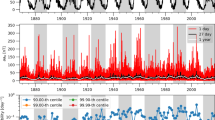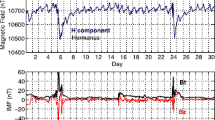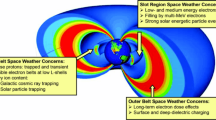Abstract
The relation of the fluxes of relativistic electrons in geostationary orbit during magnetic storms to the state of the magnetosphere and variations in the solar wind parameters is studied based on the GOES satellite data (1996–2000). It has been established that, in ∼52–65% of all storms, the fluxes of electrons with energies higher than 0.6 and 2 MeV during the storm recovery phase are more than twice as high as the electron fluxes before a storm. It has been indicated that the probability of such cases is closely related to the prestorm level of fluxes and to a decrease in fluxes during the storm main phase. It has been found that the solar wind velocity on the day of the storm main phase and the geomagnetic activity indices at the beginning of the storm recovery phase are also among the best indicators of occurrence of storms with increased fluxes at the storm recovery phase.
Similar content being viewed by others
References
D. N. Baker, R. L. McFerron, T. E. Cayton, and R. W. Klegesadel, “Linear Prediction Filter Analysis of Relativistic Electron Properties at 6.6 Re,” J. Geophys. Res. 95A, 15 133–15 140 (1990).
V. I. Degtyarev, G. V. Popov, Bingsen Xue, and S. E. Chudnenko, “Input Parameters for Models of Energetic Electrons Fluxes at the Geostationary Orbit,” Chin. J. Space Sci. 25(5), 417–423 (2005).
A. V. Dmitriev and J. K. Chao, “Dependence of Geosynchronous Relativistic Electron Enhancements on Geomagnetic Parameters,” J. Geophys. Res. 108A, SMP1/1–SMP1/12 (2003).
J. W. Freeman, T. P. O’Brien, A. A. Chan, and R. A. Wolf, “Energetic Electron at Geostationary Orbit during the November 3–4, 1993 Storm: Spatial/Temporal Morphology, Characterization by an Artificial Neural Network,” J. Geophys. Res. 103A, 26 251–26 260 (1998).
J. C. Green, T. G. Onsager, T. P. O’Brien, and D. N. Baker, “Testing Loss Mechanisms Capable of Rapidly Depleting Relativistic Electron Flux in the Earth’s Outer Radiation Belt,” J. Geophys. Res. 109A, 12211 (2004).
Junga Hwang, Kyoung Wook Min, Ensang Lee, and Dae Young Lee, “A Case Study to Determine the Relationship of Relativistic Electron Events to Substorm Injections and ULF Power,” Geophys. Res. Lett. 31, L23801 (2004).
H. C. Koons and D. J. Corney, “A Neural Network Model of the Relativistic Electron Flux at Geosynchronous Orbit,” J. Geophys. Res. 96A, 5549–5556 (1991).
X. Li, D. N. Baker, M. Temerin, et al., “Are Energetic Electrons in the Solar Wind the Source of the Outer Radiation Belt?,” Geophys. Res. Lett. 24(8), 923–926 (1997).
X. Li, M. Temerin, D. N. Baker, et al., “Quantitative Prediction of Radiation Belt Electrons at Geostationary Orbit Based on Solar Wind Measurements,” Geophys. Res. Lett. 28(9), 1887–1890 (2001).
T. Nagai, “Space Weather Forecast”: Prediction of Relativistic Electron Intensity at Synchronous Orbit, Geophys. Res. Lett. 15(5), 425–428 (1988).
T. P. O’Brien, R. L. McPherron, D. Sornette, et al., “Which Magnetic Storms Produce Relativistic Electrons at Geosynchronous Orbit,” J. Geophys. Res. 106A, 15 533–15 544 (2001).
G. D. Reeves, “Relativistic Electrons and Magnetic Storms: 1992–1995,” Geophys. Res. Lett. 25(11), 1817–1820 (1998).
G. D. Reeves, K. L. McAdams, R. H. W. Friedel, and T. R. O’Brien, “Acceleration and Loss of Relativistic Electrons during Geomagnetic Storms,” Geophys. Res. Lett. 30(10), 1529 (2003).
A. J. Smith, N. P. Meredith, and T. P. O’Brien, “Differences in Ground-Observed Chorus in Geomagnetic Storms with and without Enhanced Relativistic Electron Fluxes,” J. Geophys. Res. 109A, 11204 (2004).
D. Summers, C. Ma, and T. Mukai, “Competition between Acceleration and Loss Mechanisms of Relativistic Electrons during Geomagnetic Storms,” J. Geophys. Res. 109A, 04221 (2004).
A. Y. Ukhorsky, M. I. Sitnov, A. S. Sharma, et al., “Data-Derived Forecasting Model for Relativistic Electron Intensity at Geosynchronous Orbit,” Geophys. Res. Lett. 31, L09806 (2004).
B. S. Xue, “Study of the Enhancement Events of Relativistic Electron at the Geosynchronous Orbit,” Chin. J. Space Sci. 25(5), 383–386 (2005).
Author information
Authors and Affiliations
Additional information
Original Russian Text © V.I. Degtyarev, S.E. Chudnenko, 2007, published in Geomagnetizm i Aeronomiya, 2007, Vol. 47, No. 1, pp. 11-17.
Rights and permissions
About this article
Cite this article
Degtyarev, V.I., Chudnenko, S.E. Indicators of an increase in the flux of relativistic electrons in geostationary orbit during geomagnetic storms. Geomagn. Aeron. 47, 8–14 (2007). https://doi.org/10.1134/S0016793207010021
Received:
Issue Date:
DOI: https://doi.org/10.1134/S0016793207010021




